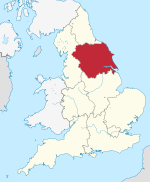Foss Island Power Station
| Foss Island Power Station | |
|---|---|
 | |
 | |
| Country | England |
| Location | North Yorkshire, Yorkshire and the Humber |
| Coordinates | 53°57′36″N 1°04′05″W / 53.960°N 1.068°WCoordinates: 53°57′36″N 1°04′05″W / 53.960°N 1.068°W |
| Commission date | 1900 |
| Decommission date | 1976 |
| Owner(s) | York Corporation (1900–1948) British Electricity Authority (1948–1955) Central Electricity Authority (1955–1957) Central Electricity Generating Board (1958–1976) |
| Operator(s) | As owner |
| Thermal power station | |
| Primary fuel | Coal |
| Turbine technology | Steam turbine |
| Chimneys | 1 |
| Cooling towers | 1 |
| Cooling source | River water and Cooling Tower |
| Power generation | |
| Units operational | 40 MW |
| Units decommissioned | All |
| Nameplate capacity | 40 MW |
| Annual net output | 54.77 GWh (1971–2) |
Foss Island Power Station, also known as York Power Station, was a small 40 MW coal-fired power station serving the city of York.[1]
It was located in the Layerthorpe area of the city,[2] to the east of the city centre.
It was built by York Corporation in the 1890s, opened in February 1900[3] and closed on 25 October 1976.[4]
History[]
In 1923 the station was supplying 3-phase AC at 400 and 230 V; DC at 460 and 230 V; and DC for traction at 500 V.[5] The steam turbine driven AC generators comprised two 1,250 kW and two 3,500 kW machines. DC current was produced by two 500 kW oil-driven machines. Electricity supplies were supplemented by a water powered generating station near Linton-on-Ouse (Linton Lock Hydro), which was commissioned in 1923 and comprised a 250 kW and a 500 kW generator. In 1923 the facilities at York generated 15.128 GWh of electricity. The sales of electricity produced a surplus of revenue over expenses of £26,938 for the Corporation.[5]
The steam plant at Foss Island were chain grate stoker boilers capable of delivering 400,000 lb/h (50.4 kg/s) of steam at 400 psi (27.6 bar) and 399/427 °C.[6] The generating capacity of the station was 40 MW. Steam condensing and cooling was by river water and a single concrete cooling tower. In the year ending 31 March 1972 the station delivered 54.772 GWh of electricity, its load factor (the average load as a percent of maximum output capacity) was 16.4 percent.[6]
The electricity output from the station, in GWh, was as follows.[7][8][9]
In 1958 the York electricity district supplied an area of 166,179 acres and a population of 152,269. The amount of electricity sold and the number and types of consumers was as follows:[7]
| Year | Electricity sold, MWh | No. of consumers |
|---|---|---|
| 1956 | 187,527 | 50,114 |
| 1957 | 197,137 | 51,362 |
| 1958 | 210,417 | 52,675 |
In 1958 the above totals were made up of the following:[7]
| Type of Consumer | No. of consumers | Electricity sold, MWh |
|---|---|---|
| Residential | 46,254 | 87,671 |
| Shops, offices, etc. | 4,895 | 36,276 |
| Factories | 256 | 76,195 |
| Farms | 1,238 | 7,025 |
| Public lighting | 32 | 3,250 |
| Total | 52,675 | 10,417 |
The buildings were demolished around 1980 and the transmission line which ran from the power station to a substation at Tang Hall Lane was dismantled at around the same time.
References[]
- ^ Jackson, Jeffrey (10 August 1961). "Why Boliers Corrode". New Scientist. No. 247. p. 334. Retrieved 17 January 2016.
- ^ "The Derwent Valley Railway". www.irsociety.co.uk. Retrieved 17 January 2016.
- ^ "Public services British History Online". www.british-history.ac.uk. Retrieved 17 January 2016.
- ^ "Coal-fired Power Stations (Hansard, 16 January 1984)". hansard.millbanksystems.com. Retrieved 17 January 2016.
- ^ a b Electricity Commissioners (1925). Electricity Supply - 1920-1923. London: HMSO. pp. 106–09, 332–37.
- ^ a b CEGB (1972). CEGB Statistical Yearbook 1972. London: CEGB. p. 15.
- ^ a b c Garrett, Frederick C., ed. (1959). Garcke's Manual of electricity supply vol. 56. London: Electrical Press. pp. A-110, A-139, B-261–262.
- ^ CEGB Annual report and Accounts, 1961, 1962 & 1963
- ^ Electricity Commission, Generation of Electricity in Great Britain year ended 31st December 1946. London: HMSO, 1947.
- Coal-fired power stations in England
- Power stations in Yorkshire and the Humber
- Former power stations in England

